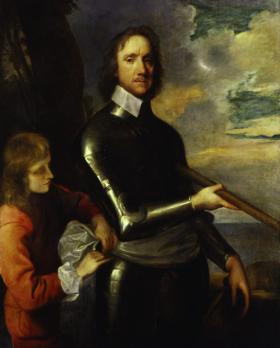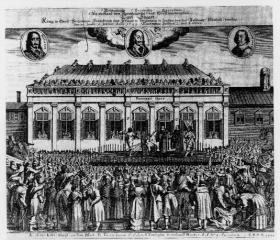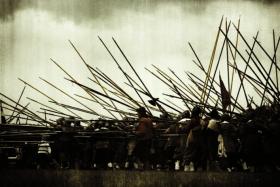The curse of Cromwell?
Published in Cromwell, Early Modern History (1500–1700), Features, Issue 5 (Sep/Oct 2008), News, Reviews, Volume 16
Robert Walker’s 1649 portrait of Oliver Cromwell, who still evokes extremely strong emotions in Ireland 350 years after his death in 1658. (National Portrait Gallery, London)
In 1997, shortly after the Labour Party’s victory in the British general election, the newly appointed foreign secretary, Robin Cook, received a courtesy visit from Bertie Ahern. The taoiseach entered Cook’s office but immediately walked out again on seeing a painting of Oliver Cromwell in the room. He refused to return until somebody removed the picture of ‘that murdering bastard’. Anxious to avoid a diplomatic incident, Cook made the necessary arrangements. The comedian and author Stephen Fry related this story at the launch of the Heritage Sector’s ‘History Matters’ campaign in 2006, and commented that ‘it was a bit like hanging a portrait of Eichmann before the visit of the Israeli prime minister’. The idea of comparing Oliver Cromwell, voted by BBC television viewers as one of the greatest Britons of all time, to a genocidal monster appears preposterous, but at least one recent academic study has claimed that the human misery visited on the Irish during the wars of the mid-seventeenth century ‘probably equalled anything inflicted on Russia or Poland in the 1940s by Nazi Germany’.
Still evokes strong emotions
There is no doubt that Cromwell still evokes extremely strong emotions in Ireland 350 years after his death in 1658. Throughout the island people blame him for every ruined castle or tower-house, while local folklore is replete with stories of terrible acts committed by his troops against the native population. Cromwell spent only nine months (August 1649 to May 1650) of his eventful life in Ireland, and yet he stands accused here of war crimes, religious persecution and ethnic cleansing on a dramatic scale. The massacre of thousands of soldiers and civilians by the New Model Army at both Drogheda and Wexford in 1649 must rank among the greatest atrocities in Anglo-Irish history, although the full extent of the slaughter is still disputed by some commentators. Irrefutable evidence, however, detailing the execution of scores of Catholic clergy, the forced transportation of thousands of women and children to work on the sugar plantations in Barbados and the deliberate targeting of the civilian population during the latter stages of the war makes decidedly uncomfortable reading for those keen to focus on Cromwell’s undoubted military and political achievements elsewhere.
But why does the public continue to focus so much on this one individual rather than on a host of other equally controversial characters? The history of Anglo-Irish relations from Henry VIII’s Reformation in the 1530s, through the horrors of the Tudor conquest and the wars of the seventeenth century is a seemingly relentless tale of bloody conflict, punctuated by periods of relative peace that enabled both sides to regroup before resuming the struggle once again. Throughout, the Catholic Irish fought stubbornly, though unsuccessfully, against a militarily superior and more unified colonial power with access to far greater resources, determined to impose its will on a people perceived as barbaric and uncivilised. Atrocities abounded, but many of the serial perpetrators, such as Sir Humphrey Gilbert in the 1570s or Charles Blount (Lord Mountjoy) in the early 1600s, remain unknown to all but a handful of historians. The defeat of the Catholic Irish in the 1650s, however, proved decisive and irreversible, creating a bitter and lasting legacy. The seventeenth-century Kerry poet Seán Ó Conaill described this conflict as an coga do chríochnaig Éire (‘the war that destroyed Ireland’), and Cromwell, the greatest Englishman of his age, was unquestionably the most ruthless exponent of his country’s uncompromising policy of conquest and colonisation.
Despised in Ireland, for centuries Cromwell’s reputation in England could best be described as highly ambiguous. Two years after his death in 1658, Charles II returned triumphantly to London from the Continent and reclaimed his father’s throne. Almost immediately he ordered the body of Oliver Cromwell to be disinterred, put through the ritual of execution and dumped in an unmarked grave. A sympathiser managed to retrieve Cromwell’s skull, which is now interred beneath the floor of his alma mater, Sidney Sussex College in Cambridge. English monarchists reviled Cromwell for his role in the execution of the ‘saintly’ Charles I, while radicals condemned him for betraying the revolution he had helped to create by ruling as a virtual military dictator for much of the 1650s. During the eighteenth century a recurring fear of excessive military interference in domestic political affairs ensured that Cromwell retained his status as the ultimate bogeyman of English history, among the ruling élite at least.

Contemporary engraving depicting the beheading of King Charles I in 1649. English monarchists reviled Cromwell for his role in the execution of the ‘saintly’ Charles. (National Portrait Gallery, London)
Carlyle’s rehabilitation provoked Irish nationalist response
Cromwell’s reputation underwent a dramatic transformation in the nineteenth century, when he emerged as the hero of the nonconforming Protestant tradition, the steadfast defender of religious and political liberties against the absolutist tendencies of the Stuart dynasty. For the brilliant but cantankerous historian Thomas Carlyle, who published a collection of Cromwell’s letters and speeches in the 1840s, he was ‘the soul of the Puritan Revolt’, the very embodiment of those traits that had enabled the English to build a global empire. Brave, resolute, godly, he was ‘not a man of falsehoods, but a man of truths; whose words do carry a meaning with them, and above all others of that time are worth considering’. Carlyle criticised ‘all the foolish lies’ that circulated about him, and decided to publish his correspondence, rather than another biography, so that the reader might ‘first obtain some dim glimpse of the actual Cromwell’.
This rehabilitation of Cromwell by Carlyle and others not surprisingly provoked a robust response from Irish nationalists. In 1865 the eminent historian J. P. Prendergast published The Cromwellian settlement of Ireland, a book based on his extensive research through state archives in Dublin (subsequently destroyed in the Four Courts in 1922). Prendergast examined post-war policy in the 1650s, particularly the forced transplantation of Irish Catholic landowners and their families into Connacht, ‘a scene not witnessed in Europe since the conquest of Spain by the Vandals’. From this injustice, he claimed, flowed many of the miseries that subsequently afflicted Ireland. Almost twenty years later, in 1883, a Jesuit priest, Father Denis Murphy, produced the first major study to focus specifically on Cromwell’s Irish campaign. Writing at a time of heightened nationalist expectations, owing to the Land War and Charles Stewart Parnell’s Home Rule movement, Murphy portrayed the conflict as a heroic, albeit doomed, struggle by the Catholic Irish in defence of their religion and culture. Critics subsequently attacked Murphy for his lurid and emotional depiction of the horrors of the Cromwellian conquest, embellished throughout with tales from local folklore of uncertain provenance. The use of such literary evidence continues to divide historians, but there is no doubt that the misdeeds of Cromwell feature prominently in Irish poetry and story-telling from the mid-seventeenth century, and such material cannot be dismissed lightly. This controversy aside, and despite the use of language somewhat too strident for modern tastes, the scholarship in Murphy’s book is incontrovertible.
For much of the twentieth century the topic of Cromwell and Ireland received scant attention from academics compared to the avalanche of material published on the English civil wars of the 1640s. The authoritative nature of the works of Prendergast and Murphy, combined with the destruction of so many of the state records relating to Ireland in the 1650s, perhaps discouraged scholars from revisiting the controversies of the past. Indeed, many English historians to this day remain unsure of how best to deal with Cromwell’s invasion of Ireland. Almost every biography of the man (and there have been many) analyses the 1649 campaign in a separate chapter, awkwardly appended to the main narrative. In the 1970s, however, historians of Ireland produced a number of important studies, with Patrick Corish’s survey chapters in the New History of Ireland series, alongside the definitive works of Toby Barnard and Karl Bottigheimer, providing the key building-blocks for further research. More recently, Ian Gentles, James Scott Wheeler, Jane Ohlmeyer, Patrick Little, Aidan Clarke, John Morrill, Pádraig Lenihan, Martyn Bennett and others have contributed enormously to our understanding of this turbulent period.
![Woodcut depicting atrocities against Protestants during the 1641 rebellion. A genuine sense of outrage at these events created the ideal conditions for Cromwell’s subsequent campaign of terror against Irish Catholics. (James Cranford’s The teares of Ireland [London, 1642])](/wp-content/uploads/2013/03/69_small_1247556757.jpg)
Woodcut depicting atrocities against Protestants during the 1641 rebellion. A genuine sense of outrage at these events created the ideal conditions for Cromwell’s subsequent campaign of terror against Irish Catholics. (James Cranford’s The teares of Ireland [London, 1642])
One book relating specifically to the topic of Cromwell and Ireland, Tom Reilly’s Cromwell: an honourable enemy, has proved particularly controversial. As the title suggests, Reilly approached the topic from the premise that Cromwell’s brutal reputation in Ireland was entirely unjustified, the result, he argues, of a deliberate distortion of the facts by nationalist historians. It is an interesting if hardly original idea, but in his eagerness to prove this thesis Reilly simply dismissed or ignored contrary evidence. As C. H. Firth said of Thomas Carlyle’s approach to Cromwell, ‘like too many other historians he found in the past just what he went to the past to find’.
Others attempt to excuse Cromwell’s actions in Ireland by drawing attention to the bloody and merciless nature of warfare in the early modern period. The Thirty Years’ War (1618–48), which devastated large tracts of central Europe at the same time, remains a byword for wholesale death and destruction, seemingly typified by the sack in 1631 of the German city of Magdeburg, where thousands perished. The excesses at Magdeburg, however, proved the exception rather than the rule and in no way explain or justify Cromwell’s shocking tactics. Nonetheless, it is important to acknowledge the extent to which Cromwell’s racial, cultural and religious prejudices mirrored those of the vast majority of his contemporaries in England, who applauded the crushing of all native resistance, regardless of the cold-blooded methods employed in achieving this goal. As the distinguished English historian S. R. Gardiner explained over a hundred years ago, the fact that Cromwell as an Englishman and Puritan ‘should have been guilty of the slaughters of Drogheda and Wexford is a matter for regret, not for surprise’.
Should be studied and understood, not revered or reviled
So how does Cromwell deserve to be remembered in the annals of Irish history? In the mid-seventeenth century, a lethal combination of racial superiority and religious bigotry, reinforced by a genuine sense of outrage at events during the initial months of the Ulster rebellion, created the ideal conditions for Cromwell’s campaign of terror against Irish Catholics. His conduct shocked contemporary opinion, not only in Ireland but also on the Continent, and almost certainly prolonged the war by a number of years. This conflict resulted in a catastrophic loss of life, of both soldiers and civilians, alongside the destruction of much of the country’s economy and infrastructure. As commander-in-chief of the army, the responsibilities for the excesses of the military must be laid firmly at his door, while the harsh nature of the post-war settlement also bears his personal imprint. According to Christopher Hill, author of God’s Englishman, Cromwell’s contempt for Irish Catholics ‘rationalised a desire to exploit’, and he found little difficulty in excusing shockingly brutal acts, such as the massacres at Drogheda and Wexford. Ireland brought out the worst in Cromwell, and provided little outlet for his undoubted talents as an inspirational leader and radical reformer. He subscribed unhesitatingly to the doctrine that ‘error has no rights’, and treated the Catholic Irish accordingly.

Battle re-enactment from Channel 4’s 2005 Blood on our hands: the English Civil War. Cromwell’s excesses in Ireland have been excused by drawing attention to the bloody and merciless nature of warfare in the early modern period. (Channel 4)
For the great English historian A. J. P. Taylor, writing on the 300th anniversary of Cromwell’s death in 1958, Ireland was the ‘one great blot’ on the great man’s reputation, and his actions there ‘beyond all excuse or explanation’. In fact, Taylor believed that the ‘curse of Cromwell’ would still be remembered when all his other achievements had been forgotten. In Ireland itself, the Protestants of Ulster, uncomfortable, perhaps, with his reputation as a regicide, choose to commemorate William of Orange instead, while for many Catholics he remains a hate figure, guilty of crimes against humanity. Cromwell was no monster, but he did commit monstrous acts. A warrior of Christ, somewhat like the crusaders of medieval Europe, he acted as God’s executioner, exacting revenge and crushing all opposition, convinced throughout of the legitimacy of his cause, and striving to build a better world for the chosen few. In many ways, therefore, he remains a remarkably modern figure, relevant to our understanding of both the past and the present, somebody to be closely studied and understood rather than revered or reviled.
Micheál Ó Siochrú’s God’s executioner: Oliver Cromwell and the conquest of Ireland has just been published by Faber & Faber.
Further reading:
J. C. Davis, Oliver Cromwell (London, 2001).
I. Gentles, The English revolution and the Wars of the Three Kingdoms, 1638–1652 (Harlow, 2007).
P. Lenihan, Consolidating conquest: Ireland 1603–1727 (Harlow, 2008).
J. S. Wheeler, Cromwell in Ireland (Dublin, 1999).
















